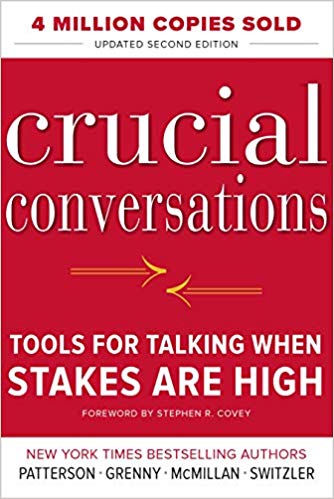

This article is an excerpt from the Shortform summary of "Crucial Conversations" by Kerry Patterson. Shortform has the world's best summaries of books you should be reading.
Like this article? Sign up for a free trial here .
Are you about to have a difficult conversation, and are looking for Crucial Conversations tools to help?
These important Crucial Conversations tools can help you stay grounded while having a difficult conversation, and make sure the attention is focused on the issue at hand.
Crucial Conversations Tools: How to Make Conversations Work
While you’re building your Crucial Conversations tools, you first have to understand the criteria for a successful crucial conversation.
For successful crucial conversations, we must:
- Share our unique information.
- Get others to share their information.
- Make it safe to discuss controversial matters.
- Amass a shared pool of information.
Fortunately, dialogue skills are learnable. When you develop the skills to master crucial conversations you can transform them from upsetting events to productive discussions.
With these Crucial Conversations tips, you’ll learn to:
- Identify your conversation style when stressed.
- Control your emotions.
- Watch for and catch dialogue-ending problems before they get out of hand.
- Create safe conditions for dialogue.
- Express feedback respectfully.
- Be persuasive, not off-putting.
- Encourage people to share their views.
- Transition from discussion to action.
The following crucial conversations tips can help you stay on track in your crucial conversation. The acronyms are easy to remember and serve as great tools for difficult conversations.
1. Use Contrasting to Repair Misunderstandings
Sometimes when you’re sharing your views in crucial conversations, others believe unjustifiably that you’re out to harm or coerce them. You shouldn’t apologize because you haven’t done anything wrong – this would be disingenuous. To rebuild mutual purpose/mutual respect when others misinterpret your purpose or intent, you can use the skill of contrasting.
Contrasting is a two-part don’t/do statement that assures others that you respect them and clarifies your purpose. You explain what you don’t want, followed by what you do want.
Contrasting works this way (using the example of the manager explaining the VP visit to employees):
- “I don’t want to imply that I don’t value your work.” (What the manager doesn’t want)
- “I think your work has been outstanding and I want the leadership to understand the value of what you do.” (What he does want)
Of the two parts of contrasting, the don’t is more important because it deals with the misunderstanding that has undermined safety. You address the misunderstanding first, then explain what you intended.
In the Yvonne/Jotham conversation earlier, Yvonne could use contrasting when she returns to the conversation on intimacy: “I don’t want to put this all on you — it’s on both of us. What I do want is to be able to talk about it so we can improve things for both of us.”
Contrasting isn’t apologizing — it provides context and proportion. Sometimes when others take your words the wrong way, you’re tempted to water down what you’re trying to say. Don’t backpedal, but put your words in context: “Let me put this in perspective…I don’t mean to imply…”
You can use contrasting preemptively as well, to enhance safety when what you’re about to say could spark defensiveness: “I don’t want you to think I don’t appreciate…but”
Practical tip: When people take something the wrong way and you start arguing over the misunderstanding, stop and use contrasting. Explain what you don’t mean until it’s safe to return to the conversation.
2. Create a Mutual Purpose
In order to have a crucial conversation, you need to be headed in the same direction. One of the Crucial Conversations tools you should know is CRIB. Sometimes you end up in a debate because purposes differ. You could ignore the problem and push ahead, give up and let others have their way, or strike a messy compromise. However, the best approach is to back up and create a shared purpose by using four skills with the acronym CRIB: Commit, Recognize, Invent, Brainstorm.
C: Commit
Commit to seeking a mutual purpose. Commit to staying in conversation until the parties come up with a purpose everyone shares. Give up your belief that your choice is the best — there may be a different choice that suits everyone. Verbalize your commitment to finding a shared purpose, even if someone else seems committed to winning. Your commitment builds safety so others can feel more confident and participate.
R: Recognize
Recognize the purpose behind the strategy: When you’re asking for something and the other person is asking for something else, you’re focused on strategy rather than what you really want. Refocusing on what you really want can help create a mutual purpose.
For example, one person wants to stay at home and the other wants to go out. These are strategies to achieve something else (a purpose that each person has). The two purposes are: to spend time together away from the kids; and to have some peace and quiet rather than running around. Their mutual purpose could be: Find something to do that is quiet and away from kids. With a mutual purpose, it will be easier to agree on a strategy.
You can break an impasse by asking, “Why do you want to do that?” Before you can agree on a mutual purpose, you need to know what people’s real purposes are. Step away from the content of the conversation, which is typically focused on strategies, and explore the purposes behind them.
When you separate strategies from purpose, new options become possible. When you focus on your real purpose you’re open to the idea of finding alternative strategies to serve everyone’s interests.
I: Invent
Invent a mutual purpose: If your goals and interests are completely at odds, you have to invent a mutual purpose. You do this by moving to more encompassing goals. For example, you and your spouse may disagree on whether you should take a promotion that requires moving to a new city. But you can agree on a larger goal: the needs of your relationship and family come before career interests. By focusing on bigger, longer-term goals, you can find ways to transcend short-term compromises that no one likes. As you can see, creating a mutual purpose is one of the most important tools for a difficult conversation.
B: Brainstorm
Brainstorm new strategies: After finding shared purpose, return to dialogue and brainstorm strategies that address everyone’s needs. You’ll no longer get bogged down in conflict because you’ve committed to finding something everyone can support. And you’re free to think outside the box.
More Crucial Conversations tips for creating safety:
- Don’t get overwhelmed thinking you have to handle every heated conversation professionally. Aim for progress, not perfection. A little progress can have big benefits.
- Prepare by thinking about which skills will help you the most in an upcoming conversation (pick a few questions to use).
- Learn how to slow down when your adrenaline kicks in.
- Remember that you’ll get better with practice.
Working all together, CRIB makes one of the powerful Crucial Conversations tools.
3. Change Your Emotions
Controlling your emotions is one of the tools for difficult conversations you might have already. But what about changing your emotions? When you have strong feelings, you can influence and often change them by thinking through them. Choosing different emotions makes it possible to then choose behaviors that lead to better results.
When you’re in an emotional state, it’s not easy to mentally reboot to regain control. To do it, you need to understand how feelings develop.
First, there’s a trigger (often something someone else says or does) to which we respond emotionally, with worry or by feeling hurt, etc. Our feelings then drive us to action (for instance, to silence or cheap shots). We go from trigger to feelings to action.
But someone’s actions alone can’t cause our emotional reactions. When faced with the same circumstances, different people have different emotional responses. What makes the difference is that after we see what someone did and before we react emotionally to it, we tell ourselves a story to interpret what we saw. This creates our emotions. Our Path to Action is: We see and hear something. We tell ourselves a story about it. We feel. We act.
Since we are the one telling the story, we can take back control of our emotions by telling ourselves a different story. You’ll be able to develop your own crucial conversations tips as you learn about your emotional responses.
4. Master Your Stories
To slow down your story-telling process and adrenaline rush, retrace your Path to Action one step at a time (going backward to the triggering event, starting with how you’re behaving):
- Act: Examine your behavior. Ask: How am I acting — with silence or violence?
- Feel: Identify your feelings. Ask: What emotions are driving me to act this way?
- Tell story: Question your stories. What story is creating these emotions?
- See/hear: Examine the facts. What observable evidence (which can be seen/heard) do I have to support this story?
By retracing your path, you enable yourself to think about, question, and change one of more of the elements.
5. STATE Your Path
Another one of the Crucial Conversations tools is to STATE your path. To have a healthy conversation about a tough topic, you must take care not to violate respect or safety with threats and accusations, despite your worst fears. To create conditions conducive to dialogue:
- Start with heart: Think about what you really want and how dialogue can help you get it
- Master your story: Realize you may be jumping prematurely to a clever story: victim, villain, or helpless.
- Think about other possible explanations, to open your mind to dialogue.
Use five skills with the acronym STATE to talk about sensitive topics:
- Share your facts.
- Tell your story.
- Ask for others’ paths.
- Talk tentatively.
- Encourage testing.
The first three skills involve what to do. The last two are how to do it.
To have a constructive conversation, you need to encourage, listen to, and understand others’ views. Start with an attitude of curiosity and patience. Use four listening skills to trace the other person’s path to action (AMPP).
- Ask: Express interest in the others’ views.
- Mirror: Acknowledge the emotions people appear to be feeling.
- Paraphrase: Restate what you’ve heard.
- Prime: If others hold back, offer a guess as to what they may be thinking and feeling to get the discussion started.
As you begin to share your views, remember ABC:
- Agree: Agree when you share views for the most part, rather than arguing over minor points of disagreement.
- Build: Agree where you can, then build. (“I agree completely. In addition, I noticed that…”)
- Compare: When you differ substantially, compare your two views. (“I think I see things differently. Let me explain.”)
These Crucial Conversations tools can be difficult to master, and they take practice and patience. Focusing on these Crucial Conversations tips can help you cultivate better communication skills in the long run.

———End of Preview———
Like what you just read? Read the rest of the world's best summary of Kerry Patterson's "Crucial Conversations" at Shortform .
Here's what you'll find in our full Crucial Conversations summary :
- How to approach an argument without getting mad
- The mistakes most people make when trying to listen to someone else
- How to come up with win-win solutions that make everyone happy






